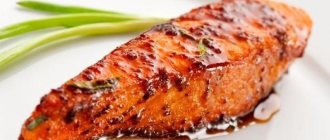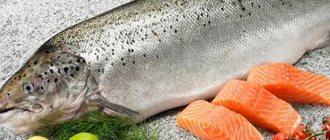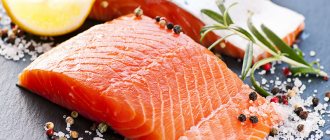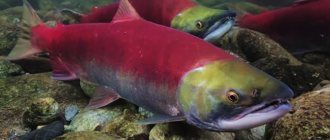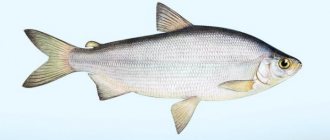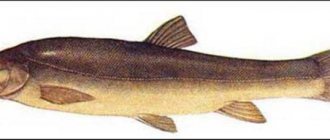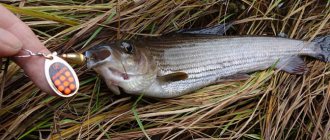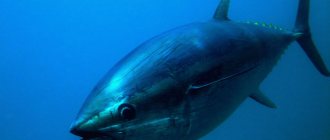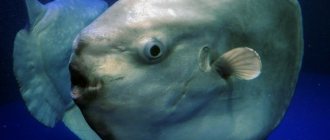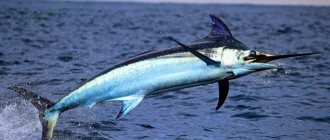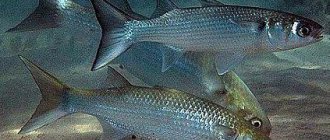What does coho salmon look like?
This Pacific salmon grows up to 98 cm. Body weight can increase to 14-15 kg. The fish found in Asia are larger than those found closer to the American coast. The silvery scales are the reason why this sea creature is called “silver salmon.” The back is darker than the sides and belly.
Salmon can be difficult to distinguish; chum salmon and coho salmon can be distinguished by the structural features of the latter. His head is massive, his forehead is wide. The caudal peduncle is larger than that of other members of the family. The caudal and dorsal fins are small in size relative to the body dimensions.
Habitats and behavioral characteristics
Coho salmon are found in the Pacific Ocean. It prefers the seas of the Northern Hemisphere as the areas in which it lives and where it lives. Along the Asian coast it is found all the way from the Anadyr River to the north-west of the Sea of Okhotsk. In eastern Sakhalin, near Hokkaido, it is rare. Along the North American coast it is distributed from Alaska to California.
Fish is a predator. Its diet consists of caddisflies, insects and their larvae, and also feeds on fish fry.
Where are coho salmon found?
We looked through the fishermen's reports and marked on the map the places where it is best to catch coho salmon.
Spawning
Spawns from June to December, reaching the age of 4-5 years. Swims into rivers to breed and can rise 600 km upstream. Before spawning, males change color: the color of their scales becomes dark crimson. They also grow a hump on their back. During spawning, silver salmon almost refuses to eat. Spawns in areas where it was born. Prefers places with a clean sandy or hard bottom. They reproduce once in a lifetime and die after spawning.
Coho salmon, jig victory.
Good evening, dear readers. Today I want to tell you about how you should never give up on the path to victory. Victory over oneself, victory over reason and sometimes common sense. Experiments, and only they, drive progress in development. The innovators in fishing today are the ones who successfully fish tomorrow. This essay will talk about three fishing trips that helped me find an approach to such fish as coho salmon.
Part one. "Character of a Winner"
Autumn is the golden time of the spinner... I'm looking forward to it. I spent the first day of autumn fishing. We went to a section of the Bystraya River, near the Malki plant. Having reached the place, we meet fellow fishermen fishing for a promising area.
The char pecked at them on almost every cast. Having settled down below, I am content with only a couple of descents and three loaches. To be honest, it’s hard to resist moving away from the line of captivity that I found myself in. Since the promising place with the hole is occupied, I make it easier to weigh the bait and comb the area adjacent to the hole and the pre-channel edge. Cast, cast, cast…. And at the other end of the cord there is just silence. Silence that screams with my question: “Why doesn’t it bite?” However, the bell that rang that day inspired me. ... During the next retrieve, I receive a powerful blow, and the rod bent into an arc holds this underwater locomotive for a couple of seconds. But... “too-too” and I am left with nothing... Who is he? Who was that? Well, it’s not a char, it’s definitely not a char... You can catch a thousand fish, but you’re unlikely to remember, for example, biting 977 individuals. But that bite, one of which I felt, is remembered for a long time... This was the beginning of the journey, the journey of mastering the fishing of a beautiful silver titanium called coho salmon.
I thought for a long time about what I might have done wrong...But comparing the experience of past years, the matter, in my opinion, was in the occupancy of a promising place. None of the floaters caught coho salmon. And based on this news, I am making adjustments to the debugging of the gear and the production of the wiring trajectory. The opportunity to show my skills presented itself a day later. The next river where I wanted to try my luck was the Paratunka River. Having found a promising hole with gyres. I anchor the boat at the exit from the snagged hole. Cast, cast, and cast again... silence again... I don't give up, I wait for the tide. Doubts overcome me, I should set “Blue Fox” and fish calmly, but..... I want to get exactly that bite that has been haunting me for several days now.
Part two “Stay on the chosen course”
The anticipation of the bait’s grip is growing, and on one of the retrieves I again feel the blow that has sunk into my memory from the last trip. I cannot describe what was happening in my mind at that second. It’s like quenching the thirst of a traveler who is almost desperate, wandering through the endless desert with one sip. My opponent goes into the stream, then onto the reach and back into the stream. A carefully adjusted friction brake of the reel helped keep his ardor in check. A minute of struggle and a silver corsair ends up in the net of the landing net. Next I will make an unforgivable mistake. The fish has deeply swallowed the bait, and when carrying it into the boat to free it from the bait, while tumbling, it catches the net with the sinker-head and tears out part of its gills, causing serious injury. The joy of being caught was sprinkled with disappointment that he did not save the life of a wonderful and strong opponent.
We take off, buy a license, explain the situation, and continue fishing, slightly changing the location. The tide was raising the water level in the river before our eyes, and we changed the position of the boat literally every half hour. When fishing, it is important to understand where the promising place or the so-called fish trail is. And these areas change with changes in water level. At one of the pauses in the retrieve, I lose contact with the bottom, an instant hook and again the silver robber falls into the net of the landing net. I unhook it and let it go overboard. This is repeated several times. By comparing many factors, I was able to persuade five coho salmon to bite. The performance of the silicone bait turned out to be excellent today. I’ll tell you a secret that I fished in a place where I was afraid to throw “Blue Foxes” because of the big snags, so the joy of catching was double. Each catch and bite brought me the necessary pieces of experience, which helped to form a fishing system.
Part three “Revenge March”
A few days later I was again in Malki. The promising place was free, and I could afford everything that was so lacking on my last trip here. A friend sets up the well-known pinwheel with a white petal and a pink bell and begins to surf the water volumes. Fishing conditions have changed a little. There were a lot of fallen leaves in the water column. The water level remained approximately the same. It is impossible to convey the feeling before the first cast, knowing the secret of fishing. On the second cast the first catch occurs. This is a loach... Cast, cast, hit, miss and hit again, hook and.... It is he !!! coho salmon
. Then, fishing a hole on the far edge, I get a second powerful bite. Again the silver locomotive ends up on the shore, a quick photo and I return it back. Then I take another one from the near channel edge, then another, another... Emotions are overflowing, it was a victory, a real reward for the great work that was done along the way to systematically catching this beautiful fish. My friend never saw a bite on the turntable. A little later, the floaters came, and what was their surprise when they caught exclusively char, and I exclusively caught coho salmon. Everything fell into place... But it didn’t last long. The hostess came with a little bear. Having driven her away, we hastily left, crossing to the other side of the river across the bridge, and she walked for a long time in the place where we had just been.
The total number of catches was 7-0 in favor of the silicone bait. As the table tennis judges would say, “Dry.”
We have taken another step towards catching king salmon with a jig. See you at the ponds, everyone has no tail, no scales.
How to catch coho salmon?
You can catch this breed using a heavy spinning rod: the fish breaks out strongly, and it can be difficult to pull it out of the reservoir. It is permissible to fish both from the shore and from a boat. If fishing is done from a watercraft, you need to use longer rods. The best catch will be if you fish from 5 to 10 a.m. and from 5 to 10 p.m.
It is important to choose the right bait. Coho salmon can be caught on a light or spinning spoon. To lure prey, you need to place the bait on a leash, the length of which is at least 50 cm. Wobblers of various shapes can also be used during fishing.
Nutritional value and calorie content
Red coho salmon fish has a pleasant taste. Its meat contains a large amount of useful substances necessary for the proper functioning of the human body. The calorie content of coho salmon is average, 140 kcal per 100 g of product. Of this, 21.6 g is protein, which is easily absorbed by the human body. Fats range from 6.9 to 9.5% depending on what season the fish was caught. The composition includes phosphorus, potassium, magnesium, fluorine, vitamins A and B, Omega-3 fatty acids. There are no carbohydrates.
Only fresh coho salmon is healthy. This type of fish can be stored for no more than 4 days. At high temperatures and exposure to sunlight, the meat of this breed quickly deteriorates.
Before eating, you need to familiarize yourself with what contraindications coho salmon has; its benefits and harms may become a reason for a number of people to include the product in the menu or refuse it. You should not eat meat of this breed if you have diseases of the liver, stomach, or individual intolerance.
Small quantities are allowed for use by pregnant women and the elderly; These categories of the population should carefully monitor the body's response to avoid complications. You should be careful when adding coho salmon meat to the menu when breastfeeding.
When choosing which fish is tastier, sockeye salmon or coho salmon, and which is better to eat, you need to focus on your own taste sensations. Sockeye salmon contains less fat. However, it has a specific taste. Most people, when choosing coho salmon or sockeye salmon, which is tastier, give preference to silver salmon. Salmon and trout have fattier meat, so when losing weight it is better to eat coho salmon.
The bright red caviar of this species is eaten. 100 g contains 270 kcal. The taste is piquant, slightly spicy.
Description of coho salmon
This is a fish that has a short oceanic residence period and is more fond of warm freshwater waters. Coho salmon have many features that separate it from other representatives of the Pacific salmon. Small hatchlings have white gums, black tongues and numerous small spots on the back.
During the oceanic phase, their body is silvery in color, with a blue metallic back, oblong in shape, flattened laterally. The square tail of the coho salmon is wide at the base with dark spots scattered over the surface, usually on the upper part. The head is large, conical in shape. During their migration to ocean waters, coho salmon develop small, sharp teeth.
The average weight of adults ranges from 1.9 to 7 kilograms. But sightings of fish outside this range are not uncommon, especially in Northern British Columbia and Alaska. Small spawning males, 25 to 35 centimeters long, are known as "jacks".
They return to their natal streams one year earlier than other adults. Depending on the life stage, these fish change their appearance. During spawning, adult males develop a distinct hooked nose and their body color also changes to red. There is a large hump behind the fish’s head, and the body is even more flattened. The appearance of the female undergoes very minor, barely noticeable changes.
Appearance
Coho salmon are often called silver salmon and have a dark blue or greenish back with silvery sides and a light belly. Fish spend a third of their life in the ocean. During this period, it has a special color with small black spots on the back and the upper lobe of the tail. When moving into fresh water during spawning, the body of the fish acquires a dark, reddish-burgundy color on the sides. Spawning males develop a curved, hooked snout and enlarged teeth.
Before the young migrate to the sea, they lose the patterns of vertical stripes and spots useful for camouflage in freshwater pools. In return, they acquire a dark back and light belly, useful for camouflage in oceanic areas.
Lifestyle, behavior
The coho salmon fish is an anadromous representative of the fauna. They are born in freshwater, spending a year in streams and rivers, and then migrate to the marine environment of the ocean to seek food for growth and development. Some species migrate more than 1,600 kilometers across the ocean, while others remain in the seas near the fresh waters in which they were born. They spend about a year and a half feeding in the ocean and then return to their natal freshwater reservoirs to spawn. This usually happens in autumn or early winter.
The death of coho salmon cannot be considered in vain. After they produce offspring and die, their bodies act as a valuable source of energy and nutrients for the ecosystem of the reservoir. Carcass abandonment has been shown to improve the growth and survival of hatchling salmon by introducing nitrogen and phosphorus compounds into streams.
Adult salmon typically weigh between 3.5 and 5.5 kilograms and range from 61 to 76 centimeters in length. Puberty occurs between 3 and 4 years of age. Upon the onset of puberty, the time comes for mating and procreation.
The female digs gravel nests at the bottom of the stream, where she lays her eggs. She incubates them for 6-7 weeks until the fry are born. All coho salmon die after spawning. Newly hatched fry remain in shallow crevices in the gravel until the yolk sac is absorbed.
How long does a coho salmon live?
Like all Pacific salmon species, coho salmon have an anadromous life cycle . The average lifespan is 3 to 4 years, but some males may die after just two years. Emerging from the egg stage during late winter, the young feed on small insects for one year before migrating to the ocean.
They spend up to two years in the ocean, growing rapidly during the last year. When mature, they complete the circle by moving to their natal waters to complete their life cycle by spawning. After spawning completes, the adults die of exhaustion, and their carcasses become the basis of the nutrient cycle in the stream ecosystem.
